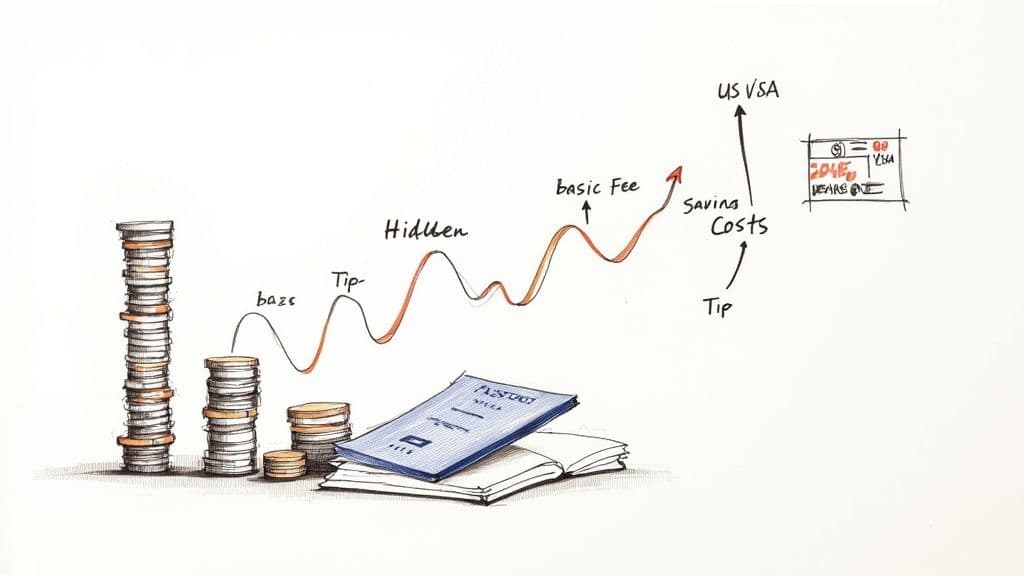The biggest and most immediate cost for a US visa application is the non-refundable Machine-Readable Visa (MRV) fee. For most common visitor visas, like the B1/B2 tourist visa, you're looking at a fee of $185.
This is the first hurdle for anyone applying from countries like Mexico, Colombia, Brazil, or for third-country nationals, such as an Indian citizen residing in Canada. It’s a mandatory payment that gets the ball rolling.
Your Guide to the Main US Visa Application Fee
Think of the MRV fee as the cover charge to get your application reviewed. It pays for the administrative work behind the scenes—from processing your forms to the time it takes for a consular officer to interview you.
Here's the key thing to remember: this fee is non-refundable. It doesn't matter if your visa is approved or denied; you pay it upfront just for the chance to be considered. You can't even book your interview appointment until this payment is confirmed.
What the MRV Fee Is
At its core, the MRV fee is what keeps the lights on at the consulate's visa processing department. It’s the standard fee for almost all nonimmigrant visa types, though the price tag can change depending on the kind of visa you're after.
The core principle is simple: every single applicant, including babies and children, has to pay their own separate MRV fee. Unfortunately, there are no family discounts or group rates for this part of the process.
This infographic gives you a quick visual on how the fee stacks up for a few of the most popular visa categories.
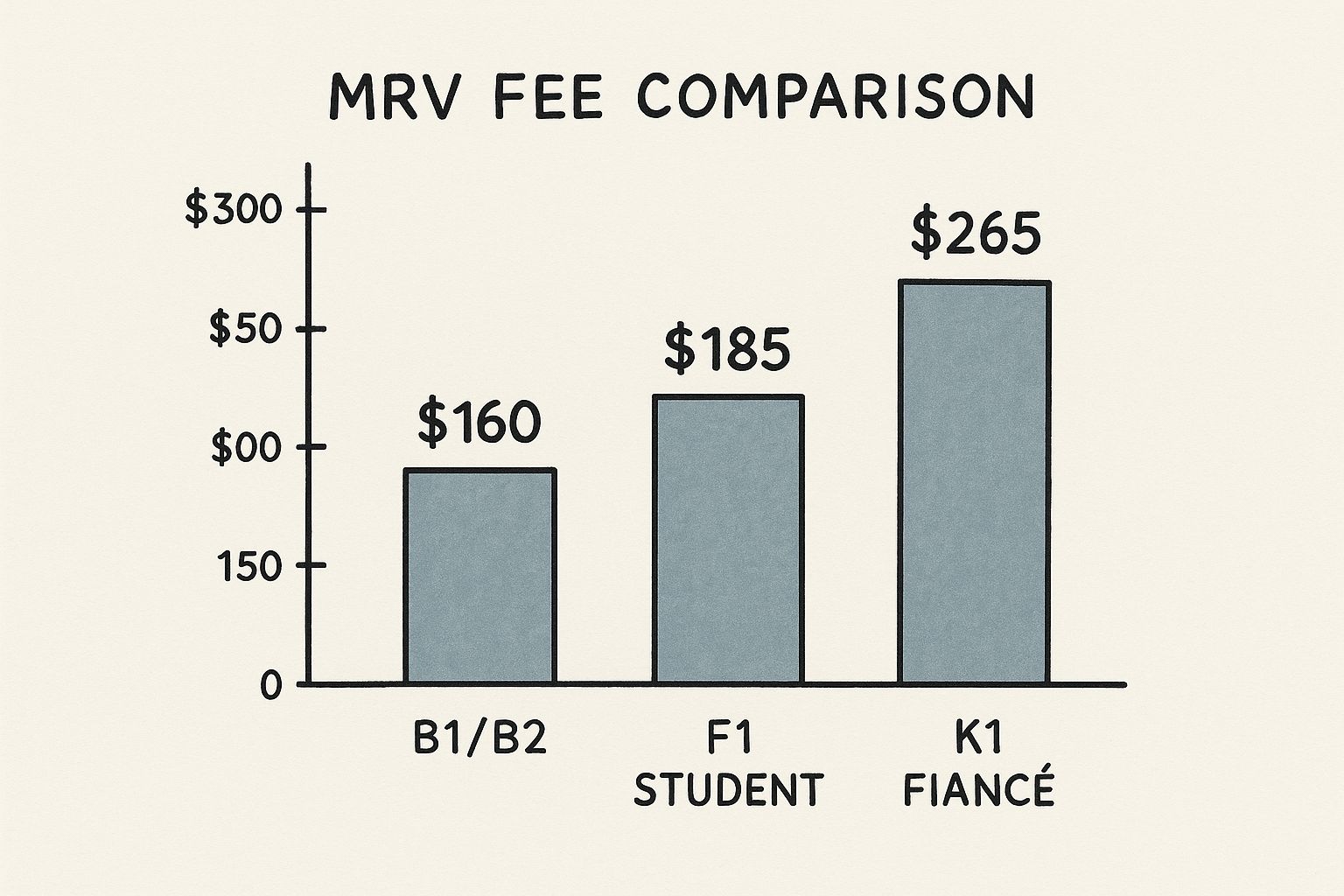
As you can see, a standard visitor visa has one price, while more specialized visas for students or fiancés have their own specific costs.
And these fees aren't set in stone. The U.S. Department of State reviews them periodically to make sure they actually cover the cost of the services. For example, on June 17, 2023, the fee for B1/B2 visas jumped from $160 to $185. It's always a good idea to check for the latest US visa fee adjustments before you start your application.
A Closer Look at Petition-Based and Immigrant Visa Costs
When you move beyond a standard visitor visa, the financial picture gets a bit more complicated. For most work or family-based visas, the process isn't something you start on your own. Instead, a sponsor in the U.S.—whether it's an employer or a family member—has to kick things off by filing a petition for you. This is a whole different ballgame compared to applying directly for a B1/B2 tourist visa.
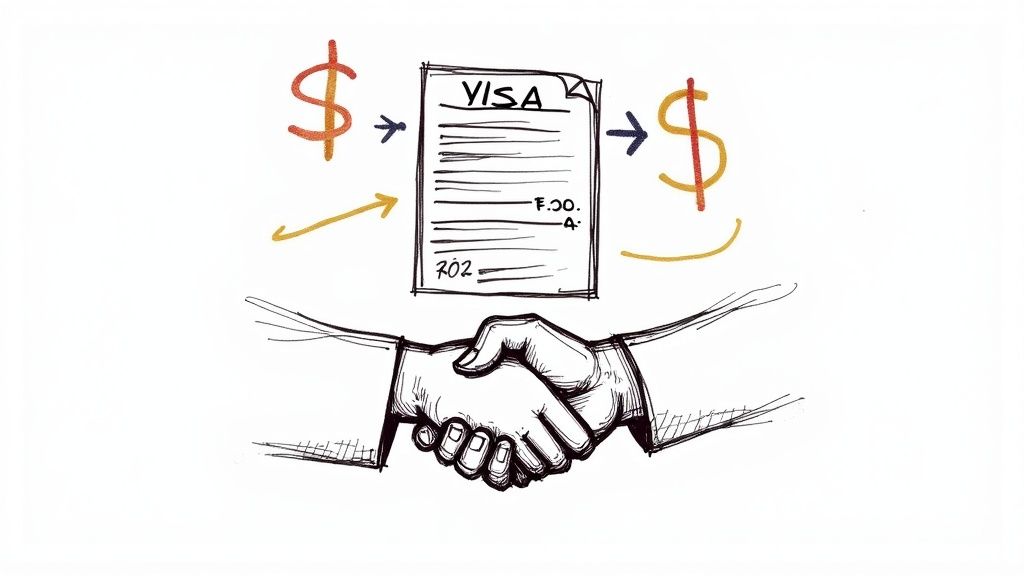
Because of this two-part structure, the total cost for a US visa application has more layers. The sponsor usually pays the initial petition fees directly to U.S. Citizenship and Immigration Services (USCIS). These are completely separate from the visa processing fees you'll pay later on at the U.S. consulate. Think of an employer filing for an H-1B temporary worker or a U.S. citizen petitioning for their spouse—both involve upfront costs that the sponsor handles.
Understanding the Split Costs
It helps to think of the process in two distinct stages, each with its own price tag.
- The Petition Fee: This is the first cost, paid by your sponsor in the U.S. to get your case approved.
- The Application Fee: This is the second cost, which you, the applicant, pay when you formally apply for the visa at a U.S. embassy or consulate in your home country.
Knowing about this split is key for planning your finances. Even if your employer or family member covers the hefty initial petition, you're still on the hook for your own application fee and any related expenses that come up. In many family-based cases, the sponsor also has to formally prove they can support you financially, a topic we cover in our guide on the affidavit of support for a tourist visa.
When it comes to immigrant visas—the ones that lead to a Green Card—the initial petition fees can be quite substantial. For instance, filing an I-130 petition for a relative costs $675. After that's approved, the immigrant visa application itself has a processing fee of $325 per person.
This dual-cost system is exactly why these visa paths feel more expensive and complex than a simple visitor visa. For a complete breakdown, you can always check the official U.S. Department of State's schedule of visa service fees.
How to Pay Your US Visa Application Fee
Figuring out how to pay your US visa application fee can feel like a mini-challenge all on its own. The rules aren't the same everywhere; they often shift based on your location. What's certain is that this fee, officially called the Machine-Readable Visa (MRV) fee, is mandatory. You have to pay it before you can even think about scheduling your interview.
First things first: you need to fill out your DS-160 application form online. After you submit it, you'll be directed to create an account on the official U.S. visa services website for your country. This portal is key—it’s where you'll get a unique payment instruction slip that shows the exact fee in your local currency.
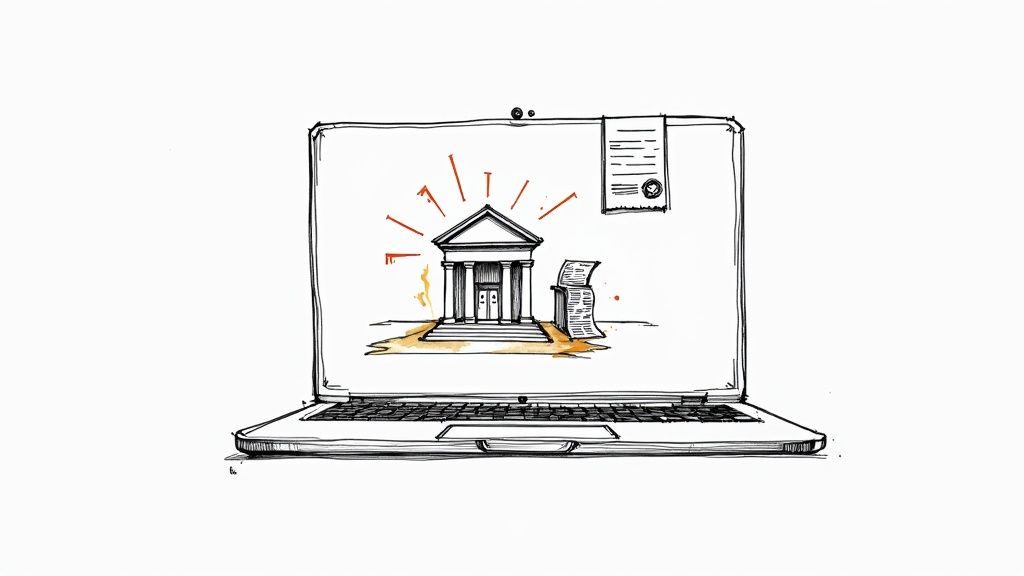
As you can see from the official schedule, the fees are listed in U.S. dollars, but how—and how much—you'll actually pay is determined by the embassy in your country.
Common Payment Methods
The options for paying the fee are entirely up to the local U.S. embassy or consulate. While this means you need to check the specific instructions for your area, most will offer at least one of these common methods:
- In-Person Bank Deposit: This is a classic. You'll likely have to take your payment slip to a specific, pre-approved bank and pay in cash. For instance, applicants in Mexico are often directed to pay at a local Scotiabank or Banamex branch.
- Online Bank Transfer: Many countries now allow you to simply wire the money directly from your bank account. You’ll use the account details provided on your payment slip to make an electronic funds transfer.
- Debit Card Online: A few embassies and consulates let you pay directly on the visa scheduling portal with a debit card, which is often the most straightforward option when available.
Think of your payment receipt as your golden ticket. You literally cannot move forward without it. The receipt number is the key that unlocks the appointment scheduling calendar, so keep it safe! Losing it can set your application back significantly.
Once your payment goes through, which can sometimes take up to two business days, you can log back into the visa portal and finally book your interview slot. For more expert advice on navigating that next step, take a look at our detailed guide on how to book a US visa appointment.
Budgeting for Hidden and Additional Visa Costs
Think of the main visa application fee (the MRV fee) as the price of admission. It gets you in the door, but it doesn't cover everything. A whole range of other smaller, often unexpected costs pop up throughout the process, and they can really add up.
Forgetting to budget for these extras is a classic mistake that can throw your plans into a tailspin. Let’s break down what else you need to account for.
It all starts before you even fill out the application. You'll need brand new passport photos that meet the very specific U.S. government requirements. And, of course, you need a valid passport. If you don't have one or yours is about to expire, that's your first additional expense. You can get a full rundown of those charges in our guide to the cost of a passport.
Planning for Travel and Logistics
One of the biggest "hidden" costs is simply getting to your interview. Unless you're lucky enough to live right next to a U.S. embassy or consulate, you’ll have to budget for transportation. For many people, especially in large countries like Brazil, Canada, or Colombia, this could mean a plane ticket or a long bus journey.
Don't forget about potential accommodation costs. If your interview is early in the morning and you live hours away, you may need to book a hotel for the night before, adding another line item to your budget.
Once the interview is over, you also need to think about getting your passport back. Most embassies use a courier service to securely return your documents, and this service comes with its own fee.
Understanding Reciprocity Fees
Finally, there’s a wildcard fee you might encounter: the reciprocity fee. This is an extra charge that only applies to citizens of certain countries after their visa has been approved.
Essentially, it’s a "tit-for-tat" fee. If your home country charges U.S. citizens for a similar type of visa, the U.S. government will charge you a reciprocal amount. This isn't a universal fee and varies widely. For example, a B1/B2 visa applicant from Chile might pay nothing extra, while someone from Nigeria could face a significant fee.
You can check if a reciprocity fee applies to your country and visa type by visiting the U.S. Department of State's official fee schedule.
The main application fee is just the starting point. To help you build a complete and realistic budget, here's a checklist of common expenses you might encounter along the way.
Common Additional Costs for a US Visa Application
| Expense Category | Typical Cost Range (USD) | Important Notes |
|---|---|---|
| Passport Photos | $10 - $20 | Must meet strict size, background, and age requirements. |
| Passport Book | $130 - $200+ | Required for all visa applications. Cost varies for new vs. renewal. |
| Travel to Embassy | $20 - $500+ | Highly variable; depends on distance (bus, train, or flight). |
| Accommodation | $75 - $250+ | Only necessary if you need to stay overnight near the consulate. |
| Document Courier | $15 - $40 | Fee for secure return of your passport after visa processing. |
| Reciprocity Fee | $0 - $300+ | Paid after visa approval. Only applies to certain nationalities. |
Keeping these potential expenses in mind from the beginning helps ensure there are no last-minute financial surprises, allowing you to focus on what really matters: preparing for a successful visa interview.
A Closer Look at Employment Visa Fee Changes
When it comes to U.S. visa costs, it's a tale of two different worlds. On one side, you have standard visitor visas. On the other, you have employment-based visas, which are a whole different ballgame. The fees for these sponsored work visas can shift dramatically based on new government policies.
Understanding this distinction is helpful, even if you're just applying for a B-1/B-2 tourist or business visa. It puts the entire cost structure into perspective.
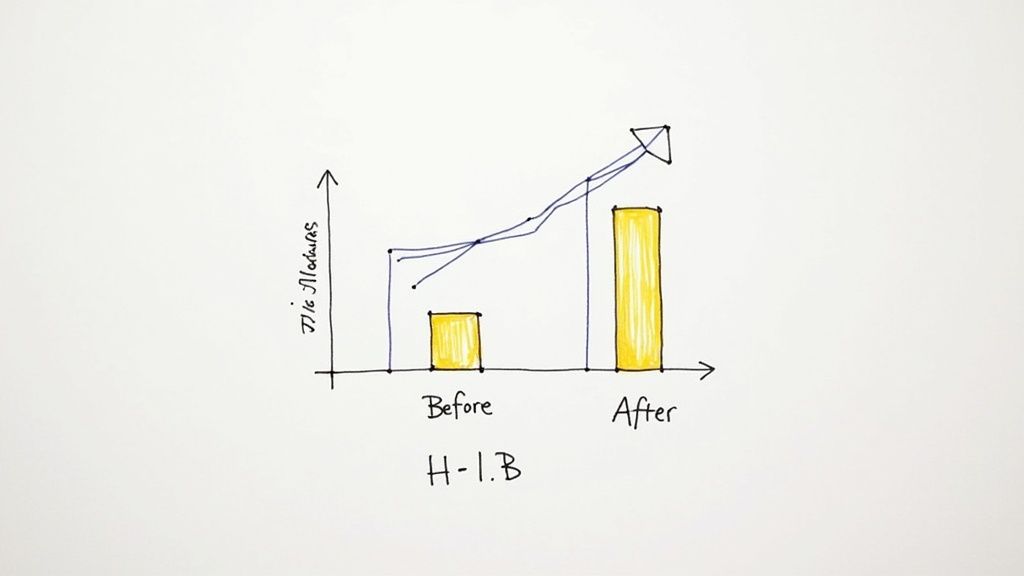
These major policy changes almost always target specialized, petition-based visas like the H-1B for skilled professionals. They're designed to impact the U.S. employers who sponsor international talent, not the individuals coming for a short visit.
How Policy Shapes Visa Costs
One of the most talked-about recent developments is the proposed $100,000 fee for H-1B visa applications, slated to take effect on September 21, 2025. This isn't a small adjustment; it's a monumental leap that could make it incredibly difficult for companies and even universities to hire top talent from around the globe. You can read more about the H-1B fee on americanimmigrationcouncil.org.
So, what does this mean for B-1/B-2 applicants from countries like Brazil, Mexico, or Colombia? It's actually reassuring. Your application process is much simpler and isn't the focus of these kinds of sweeping financial changes. While your fees might go up slightly over time to account for inflation, they are far more stable and predictable.
The key takeaway is simple: the biggest, most unpredictable visa costs fall on the shoulders of U.S. employers petitioning for foreign workers. Individuals applying for short-term tourism or business trips face a much more stable fee structure.
This is a crucial point when you're budgeting for your trip. If you're planning to attend meetings or conferences, your main focus should be on meeting the standard requirements. You can review our guide on the business visa requirements for the US to make sure you have everything in order without worrying about these massive employment-related fee hikes.
Common Questions About US Visa Fees
Let's clear up some of the most common questions that come up when you're figuring out the financial side of your visa application. Knowing these details upfront can save you a lot of confusion and help you budget properly.
Can I Get My Money Back if My Visa Is Denied?
Unfortunately, no. The MRV (Machine-Readable Visa) application fee is non-refundable, plain and simple.
It's best to think of it as a processing fee that covers the consulate's time and effort to review your case. Whether you get approved or denied, they've done the work, so that fee isn't returned. It's also non-transferable, so you can't pass the payment receipt to someone else for their application.
Will I Pay in US Dollars or My Country's Currency?
You'll almost always pay in your local currency. When you go through the official U.S. visa services website for your country, the system does the math for you. It automatically converts the fee using the current consular exchange rate and tells you the exact amount to pay.
How Long Is My Fee Payment Good For?
Your payment is valid for one year from the date you make it. This gives you a 365-day window to schedule your interview.
Be careful with this deadline. If you don't book an interview within that year, the fee expires. You'll lose that money and have to pay all over again to move forward.
It’s a strict rule, so once you've paid, it's a good idea to get your appointment on the calendar without too much delay.
Does My Baby or Child Have to Pay the Full Fee?
Yes, every single person applying for a visa needs their own application and must pay the full fee. This includes infants and young children traveling with you.
There are no family discounts or special rates for minors—the fee is per person. This is a crucial cost to factor into your budget, especially when traveling as a family. Make sure you also have all the necessary paperwork for them, which you can review in our B-2 visa documents checklist.
Struggling with long visa wait times? Vast Fisa finds and books earlier appointment slots for you automatically, saving you months of waiting. Stop checking the calendar and start planning your trip. Find an earlier visa appointment with Vast Fisa.
